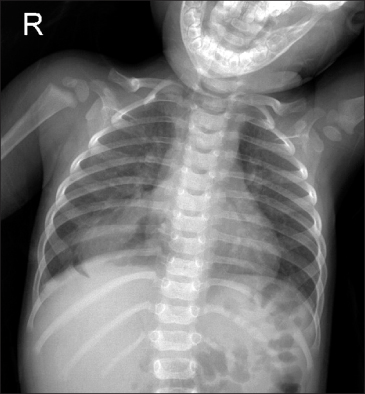Pediatr Gastroenterol Hepatol Nutr.
2012 Jun;15(2):100-104.
A Case of Congenital Paraesophageal Hiatal Hernia in Infancy
- Affiliations
-
- 1Department of Pediatrics, Hanil General Hospital, Seoul, Korea. yellowann12@hanmail.net
- 2Department of Radiology, Hanil General Hospital, Seoul, Korea.
- 3Department of Pediatric Surgery, Seoul National University College of Medicine, Seoul, Korea.
Abstract
- Esophageal hiatal hernia is the hernia of a part of or the whole of stomach to posterior mediastinum through esophageal hiatus. Esophageal hiatal hernia can be classified as sliding hiatal hernia (type I), paraesophageal (type II), combined sliding and paraesophageal (type III), and complex paraesophageal (type IV). Type III and IV are clinically classified as paraesophageal hernia. The authors by chance found cystic mass filled with air in the lower lobe of the right lung during the treatment of mycoplasma pneumonia of 10 month-old patient. It was found to be paraesophageal hernia on the chest computed tomography and treated with the operation. As complex paraesophageal hernia is not usual among infants, the authors report it here with literature review.
MeSH Terms
Figure
Reference
-
1. Skinner DB, Belsey RHR. Surgical management of esophageal reflux and hiatus hernia: Long term results with 1,030 patients. J Thorac Cardiovasc Surg. 1967. 53:33–54.2. Naunheim KS, Baue AE. Shields TW, editor. Paraesophageal hiatal hernia. General thoracic surgery. 1994. 4th ed. Malvern: Williams & Wilkins Co.;644–651.3. Jeon YH, En SY, Lee SI, Kim SW, Son KH, Lee NS. A case of congenital esophageal hiatal hernia. Inje Med J. 1983. 4:437–442.4. Hong YS, Son YM, Kim BK. Congenital hiatal hernia associated with Anemia. J Korean Pediatr Soc. 1982. 25:523–527.5. Rhou HM, Moon EK, Lee DC, Im HK, Yu JH, Sul JY, et al. A Case of Cogenital Esophageal Hiatal Hernia Simulating Chest Mass. Korean J Pediatr Gastroenterol Nutr. 1999. 2:211–216.
Article6. Hong JY, Song KY, Lee WK, Kim KW, Ha JK, Choi SO. Two cases of congenital paraesophageal hiatal hernia in infancy. J Korean Pediatr Soc. 2000. 43:1613–1620.7. Kim HK, Kim KM, Kwon ES, Lee HL, Kim JW, Lee SK, et al. Paraesophageal hiatal hernia in newborn -a case report-. Korean J Thorac Cardiovasc Surg. 1992. 25:1436–1439.8. David BS. Gibbon JH, Sabistion DC, Spencer FC, editors. Esophageal hiatal hernia. Surgery of the chest. 1990. 5th ed. Philadelphia: W.B Saunders Company;890–902.9. Hashemi M, Sillin LF, Peters JH. Current concepts in the management of paraesophageal hiatal hernia. J Clin Gastroenterol. 1999. 29:8–13.
Article10. Alrabeeah A, Giacomantonio M, Gillis DA. Paraesophageal hernia after nissen fundoplication: a real complication in pediatric patients. J Pediatr Surg. 1988. 23:766–768.
Article11. Ozdemir LA, Baue AE. Shields TW, editor. Paraesophageal hiatal hernia. General thoracic surgery. 1994. 4th ed. Malvern: Williams & Wilkins Co.;644–651.12. Jawad AJ, al-Samarrai AI, al-Mofada S, al-Howasi M, Hawass ED, al-Beiruti Z. Congenital paraesophageal hiatal hernia in infancy. Pediatr Surg Int. 1998. 13:91–94.13. Wo JM, Branum GD, Hunter JG, Trus TN, Mauren SJ, Waring JP. Clinical features of type III (mixed) paraesophageal hernia. Am J Gastroenterol. 1996. 91:914–916.14. Lee JW, Kim HS, Ryu BY, Kim HK, Han SJ. Paraesophageal hernia with small bowel strangulation. J Korean Surg Soc. 2010. 78:195–198.
Article15. Blamey S. Classifyng hiatus hernia. Does it make a difference to management? Aust Fam Physician. 1998. 27:481–485.
- Full Text Links
- Actions
-
Cited
- CITED
-
- Close
- Share
- Similar articles
-
- Congenital Hiatal Hernia Associated with Anemia
- Two Cases of Congenital Paraesophageal Hiatal Hernia in Infancy
- A Case of Sliding Hiatal Hernia associated with Bochdalek Hernia Repair
- A Case of Cogenital Esophageal Hiatal Hernia Simulating Chest Mass
- A case of paraesophageal hernia repaired by laparoscopic approach




